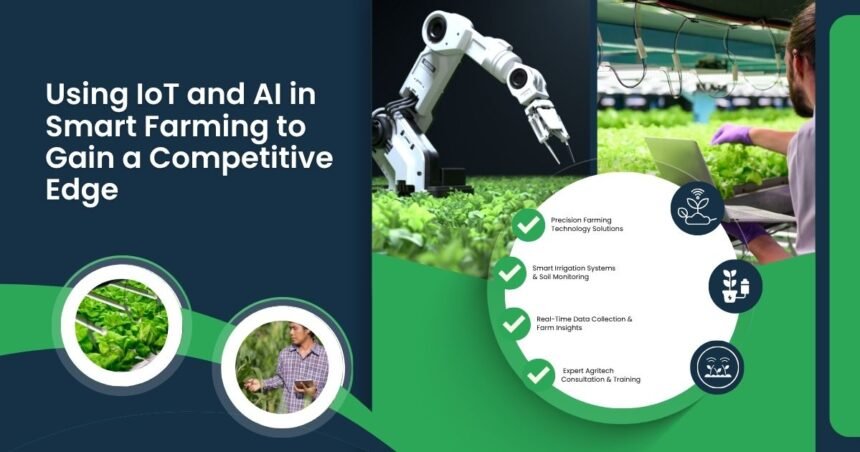Global food demand is expected to rise by 60% by 2050, according to the Food and Agriculture Organization (FAO). Meanwhile, the global smart farming market is projected to reach $34.1 billion by 2026. This rapid growth stems from the need for sustainable farming practices, efficient resource use, and data-driven decision-making.
The integration of the Internet of Things (IoT) and Artificial Intelligence (AI) is reshaping how farms operate. These technologies enable precise control over farming processes, helping producers gain a significant edge in yield, cost, and productivity.
Companies that deliver Smart Farming Solutions and those operating as an IoT Development Company play a crucial role in this shift. Their technologies help solve practical problems such as water waste, pest control, and crop health monitoring.
What Is Smart Farming?
Smart farming involves using connected technologies to monitor and manage agricultural operations. It includes IoT sensors, AI algorithms, mobile applications, and cloud-based analytics.
These systems collect and analyze data to guide decisions. Farmers can now track soil conditions, weather patterns, and crop health from anywhere. This real-time feedback enables better planning and reduces input costs.
Also Read: IoT in Hospitality: How Smart Devices Are Enhancing Guest Experiences
Key Technologies in Smart Farming
IoT (Internet of Things)
IoT refers to the network of physical devices embedded with sensors and software. These devices collect and transmit data across the farming environment.
Examples of IoT Devices in Agriculture:
- Soil moisture sensors
- Weather stations
- Livestock trackers
- Automated irrigation systems
- Drone-mounted cameras
Each sensor continuously sends data to a central platform for real-time analysis and action.
AI (Artificial Intelligence)
AI systems interpret large volumes of sensor data. They apply machine learning to identify patterns, forecast outcomes, and make recommendations.
AI Use Cases in Smart Farming:
- Predictive analytics for crop yields
- Pest and disease detection
- Livestock health monitoring
- Fertilizer application planning
- Automated drone navigation
By analyzing trends, AI systems provide actionable insights that lead to better outcomes.
Benefits of IoT and AI in Agriculture
Increased Efficiency
IoT sensors help farmers monitor soil, water, and temperature conditions. This information guides resource use and reduces waste.
- Irrigation adjusts based on soil moisture readings
- Fertilizer is applied only where needed
- Equipment operates when conditions are optimal
These actions reduce energy and input costs significantly.
Better Crop Management
AI systems analyze satellite images and drone footage. They detect early signs of disease or pest activity. Early intervention prevents large-scale crop loss.
Farmers can also monitor crop maturity and harvest timing to optimize yield quality.
Reduced Environmental Impact
Precise application of water, pesticides, and fertilizers lowers runoff and pollution. AI models help farmers predict the best times to plant and irrigate based on local weather and soil data.
This reduces environmental damage and improves sustainability.
Improved Livestock Care
Wearable IoT devices track vital signs and activity levels in livestock. AI monitors this data for irregularities. Farmers get instant alerts if an animal shows signs of illness or distress.
This leads to better animal welfare and reduced veterinary costs.
Real-World Use Cases
Precision Irrigation
Smart irrigation systems use soil sensors and weather data to decide when and how much to water. Farmers in arid regions report water savings of up to 40%.
Disease Detection with AI
AI tools analyze leaf images to detect fungal infections or nutrient deficiencies. This helps apply treatment early, avoiding full crop damage.
Livestock Monitoring
IoT collars track cattle movement and behavior. Changes in activity can signal illness or stress. Farmers can intervene quickly, improving livestock health outcomes.
Role of an IoT Development Company
An IoT Development Company designs and builds the connected devices used in smart farming. These companies provide the hardware, software, and cloud infrastructure needed to run a complete system.
Key Services Provided:
- Sensor and device engineering
- Network architecture design
- Data management platforms
- Integration with mobile apps
- Custom firmware and software
Partnering with a development company ensures the technology fits the farm’s specific needs. They also provide long-term technical support and maintenance.
Also Read: Why Businesses Need Expert Hardware Engineering Services for Successful Product Launches
Smart Farming Solutions: Components and Workflow
A complete Smart Farming Solution includes several integrated parts:
1. Data Collection
IoT devices collect data from various sources:
- Soil composition and pH
- Air temperature and humidity
- Rainfall and wind conditions
- Crop images from drones or satellites
2. Data Transmission
Data is transmitted via Wi-Fi, LoRaWAN, cellular networks, or satellite. Edge computing allows initial data processing on-site to reduce delays.
3. Data Processing
AI algorithms analyze data in real-time or batch mode. Machine learning models detect trends and outliers.
4. Decision Making
Based on analysis, the system generates actionable recommendations:
- Adjust irrigation levels
- Schedule pesticide application
- Recommend replanting or rotation
5. Action Execution
Automated systems carry out the recommended actions, or notify farmers via mobile alerts.
Integration with Farm Management Systems
Smart farming platforms integrate with existing farm management software. This centralizes operations like:
- Crop planning
- Labor scheduling
- Inventory control
- Financial reporting
The result is a single dashboard for managing the entire agricultural operation.
Challenges in Adopting Smart Farming
Despite the advantages, adoption has some hurdles.
High Initial Costs
Installing IoT devices and AI systems requires investment in hardware, connectivity, and software licenses.
Technical Skills Required
Farmers need to learn how to use the new tools. Training and ongoing support are essential for success.
Connectivity Limitations
Many rural areas lack reliable internet. IoT systems must work in low-bandwidth conditions or rely on offline data storage.
Data Privacy Concerns
Collected data must be stored and shared responsibly. Farmers must ensure compliance with regional data protection laws.
Solutions to Adoption Barriers
Modular Deployment
Farmers can start with one system, such as smart irrigation, and expand later. This reduces upfront costs.
Training Programs
IoT and AI providers offer hands-on training. These programs help farmers become comfortable with new technologies.
Offline Functionality
Some systems support local data logging and delayed syncing. This allows functionality even in areas without internet.
Future Outlook
By 2030, smart farming will be the standard for large-scale agriculture. Technologies will continue to improve in accuracy and affordability. Smaller farms will also benefit as cost barriers decrease.
Key trends to watch:
- Increased use of 5G in rural areas
- Growth in satellite-based crop monitoring
- More AI-driven automation in greenhouses
- Expansion of shared platforms for data analysis
Conclusion
Smart farming supported by IoT and AI delivers measurable improvements in productivity, resource use, and profitability. Real-time data collection and intelligent analysis help farms respond faster and operate more efficiently.
Whether through a specialized IoT Development Company or tailored Smart Farming Solutions, farmers are gaining a competitive advantage. As environmental and market pressures grow, these technologies will be essential for long-term agricultural success.








